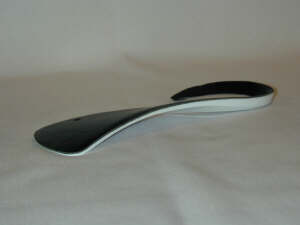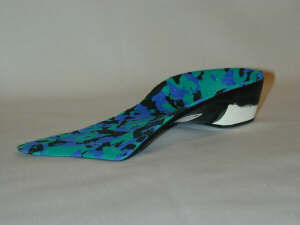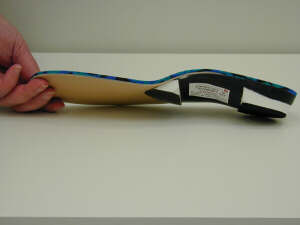Types of Orthotics
The orthotic prescription is customized to the patients needs. The contours of the plate can be modified to enhance control. Two such modifications are; Inverted technique and the Kirby skive. Rearfoot and forefoot posts may provide additional control and correct for positional abnormalities. Orthotics may be customized for certain types of shoes or particular activities.
The examples below are not exhaustive, they simply illustrate some common examples of orthotic types.

This is a standard polypropylene orthotic with a vinyl top cover and a rearfoot post made of EVA (ethyl vinyl acetate). It is metatarsal length, extending to just behind the ball of the foot.

This is an orthotic cut for dress shoes with low heel height. It is similar to the standard orthotic above, but is cut more narrow with a lower bulk rearfoot post.

This is an orthotic cut for dress shoes with low heel height. It is similar to the standard orthotic above, but is cut more narrow with a lower bulk rearfoot post.

This orthotic is for high heeled dress shoes. Women who must wear this type of shoe, can do so with greater comfort.

This is a sports orthotic. It is often cut wider and made of more flexible plastics or carbon-fiber composite material. Orthotics are sometimes customized for particular sports such as court sports, running, basketball, skiing, etc.

This is a gait plate. It is made for young children with structural foot abnormalities.

This illustrates an orthotic with a rearfoot post, a forefoot post, and a full-length top cover. The plate is made of a copolymer which provides increased flexibility and shock absorption. This orthotic is for a patient with a high-arched foot.

This is a orthotic mold. It is soft and flexible, and extends full-length. It is appropriate for certain high-arched feet, and elderly patients or those with advanced arthritis.

This orthotic incorporates three layers of different materials which together help to cushion and accommodate for painful areas and calluses. It is for the high-risk or deformed foot. We often prescribe this for diabetics.
